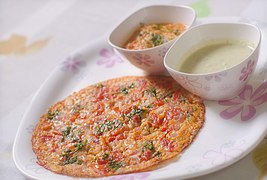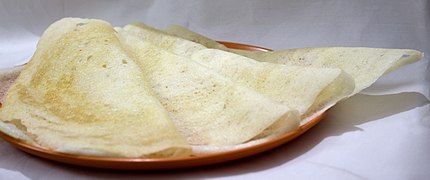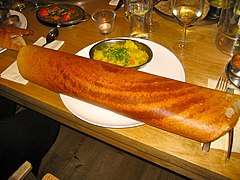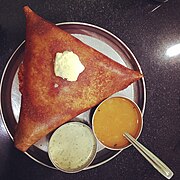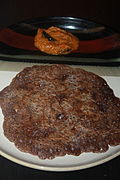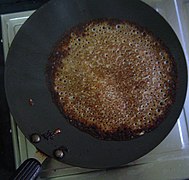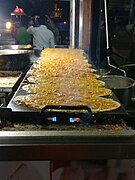A dosa, dose, dosai or dosha is a thin, savoury crepe in South Indian cuisine made from a fermented batter of ground black gram and rice. Dosas are served hot, often with chutney and sambar (a lentil-based vegetable stew). Dosas are popular in South India as well as around the world.
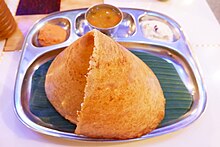 | |
| Type | Pancake, crepe |
|---|---|
| Place of origin | India |
| Region or state | Southern India |
| Serving temperature | Hot |
| Main ingredients | Rice and black gram |
| Variations | Masala dosa, rava dosa, ghee roast dosa, paneer dosa, plain dosa, and many more |
History


The dosa originated in South India, but its precise geographical origins are unknown. According to food historian K. T. Achaya, references in the Sangam literature suggest that dosa was already in use in the ancient Tamil country around the 1st century CE.[1] However, according to historian P. Thankappan Nair, dosa originated in the town of Udupi in present-day Karnataka.[2] Achaya states that the earliest written mention of dosa appears in the 8th-century literature of present-day Tamil Nadu, while the earliest mention of dosa in Kannada literature appears a century later.[3]
In popular tradition outside of Southern India, the origin of the dosa is linked to Udupi, probably because of the dish's association with Udupi restaurants.[3] The Tamil dosa is traditionally softer and thicker; the thinner and crispier version of dosa was first made in present-day Karnataka.[4] A recipe for dosa can be found in Manasollasa, a 12th-century Sanskrit encyclopedia compiled by Someshvara III, who ruled from present-day Karnataka.[5]
The dosa arrived in Mumbai with the opening of Udupi restaurants in the 1930s.[6] After India's independence in 1947, South Indian cuisine became gradually popular in North India. In New Delhi, the Madras Hotel in Connaught Place became one of the first restaurants to serve South Indian cuisine.[7][8]
Dosas, like many other dishes of South Indian cuisine, were introduced in Ceylon (Sri Lanka) by South Indian emigrants during British rule.[9][10] Tirunelveli and Tuticorin merchants who settled there were instrumental in the spreading of South Indian cookery across the island by opening restaurants (vegetarian hotels) to meet initially the needs of the emigrant population.[11][12] Dosa has found its way into the culinary habits of the Sri Lankan people, where it has evolved into an island-specific version which is quite distinct from the Indian dosa. In both forms, it is called those (තෝසේ or [t̪oːse]) or thosai (தோசை or [t̪oːsaɪ̯]) in Sinhala and in Sri Lankan Tamil.
Apart from these countries, dosa was introduced far abroad since the early 18th century, by the migration of the Tamil diaspora to Southeast Asia and latter in the Western World. As well through the worldwide popularisation of Indian and South Indian cuisines, since the second half of the 20th century.
Names


Dosa is the anglicised name of a variety of South Indian names for the dish, for example, dosai in Tamil, dosey in Kannada and dosha in Malayalam.
The standard transliterations and pronunciations of the word in various South Indian languages are as follows:
Nutrition
Dosa is high in carbohydrates and contains no added sugars. As its key ingredients are rice and black gram, it is a good source of protein.[14] A typical homemade plain dosa without oil contains about 112 calories, of which 84% is carbohydrate and 16% is protein.[15] The fermentation process increases the vitamin B and vitamin C content.[16]
Preparation
A mixture of rice and white gram that has been soaked in water for at least 4–5 hours is ground finely to form a batter. Some add a bit of soaked fenugreek seeds while grinding the batter. The proportion of rice to lentils is generally 3:1 or 4:1. After adding salt, the batter is allowed to ferment overnight, before being mixed with water to get the desired consistency. The batter is then ladled onto a hot tava or griddle greased with oil or ghee. It is spread out with the base of a ladle or a bowl to form a pancake. It can be made either thick like a pancake, or thin and crispy. A dosa is served hot, either folded in half or rolled like a wrap. It is usually served with chutney and sambar. The mixture of white grams and rice can be replaced with highly refined wheat flour or semolina.
- Rice batter
- Batter poured on a tava or griddle
- Batter being spread uniformly
- After being cooked for some time
Serving
Dosas can be stuffed with fillings of vegetables and sauces to make a quick meal. They are typically served with a vegetarian side dish which varies according to regional and personal preferences. Common side items are:
- Sambar
- Chutney
- Idli podi or milagaipodi: a lentil powder with spices and sometimes desiccated coconut, mixed with sesame oil or groundnut oil or ghee
- Indian pickles
Variations
Masala dosa is a roasted dosa served with potato curry, chutney and sambar, while saada (plain) dosa is prepared with a lighter texture; paper dosa is a thin and crisp version. Rava dosa is made crispier using semolina.[17] Newer versions include Chinese dosa, cheese dosa, paneer dosa, and pizza dosa.[18]
Though dosa is typically made with rice and lentils, other versions exist.[19]
| Name | Description |
|---|---|
| Masala dosa | Roasted and crispy dosa. Served with potato curry, chutney and sambar. |
| Oats dosa | Healthy, crisp and lacy instant dosa made with oats. |
| Wheat dosa | Dosa made with wheat flour batter. |
| Set dosa | Spongy, soft and light, served in a set of 2-3 dosa per serving. |
| Plain dosa | Dosa has lighter texture can be crispy too. |
| Ghee roast | (Nei dosai in Tamil) Plain dosa cooked with Ghee instead of oil and usually with no filling. |
| Egg dosa | (Muttai dosai in Tamil) A thicker base of dosa topped with beaten egg, or beaten egg is added to batter before cooking. |
| Kari dosai | A Tamil Nadu specialty with a dosa of thicker base topped with cooked meat, usually chicken or mutton. |
| Paneer dosa | Spiced, flavorful paneer filling inside the dosa. |
| Palak dosa | Layered with palak (spinach) paste inside the folds of dosa. |
| Mini soya dosa[20] | Soya milk and wheat flour[21] |
| Pesarattu (green dosa)[22] | Made with green gram.[23] It is served with Allam Pachadi. (Ginger chutney) |
| Adai dosa | From Tamil Nadu a dosa-like dish prepared from a combination of toor dal, rice, curry leaves, red chillies and asafoetida. The batter is not fermented. Usually eaten with jaggery or aviyal. |
| Light white dosa | Rice and coconut.[24] |
| Kadapa Neyyi karam dosa[25] | Rice flour fermented overnight and mixed with sodium carbonate. The topping is a mixture of onion and chili paste (called yerra karam) and a chutney made with tomato and flour made in a gravy of curd. It is roasted in Ghee. It is also occasionally topped with fried gram powder.[25] |
| Onion rava dosa[26] | Semolina, rice flour, onion |
| Ragi wheat dosa | Ragi, whole wheat flour[27] |
| Rava dosa | Made with rava or sooji (semolina). |
| Benne dose | Made with butter ('benne' in Kannada) ('vennai' in Tamil). Predominantly famous as "Davanagere benne dose" associated with Davanagere district in Karnataka. |
| Neer dosa | Made with a watery rice batter. |
| Vodu dose or Kappa roti | Vodu dose or Kappa roti is made from unfermented rice, fenugreek seeds, grated coconut, thinly flattened rice and sometimes leftover cooked rice. It is cooked on an earthen pan with a rounded bottom. It is fluffy and appears like a bread. It is cooked without the use of oil. |
| Amboli, ghavan, dhirde | In coastal parts of Maharashtra, variations known as amboli and ghavan are thin rice crêpes prepared with fermented batter, while dhirde is prepared with unfermented batter. |
| Buttermilk dosa | Semolina, maida, buttermilk.[28] |
| Jaggery dosa | Rice flour, maida, grated coconut, jaggery. |
| Minapattu | Very similar to plain dosa. However, this version tends to be thicker and, compared to plain dosa, it has a greater ratio of urad dal to rice flour or, in some cases, idli rava. |
| Maida dosa | The Maida dosa batter is made from Maida(refined flour) by adding water to get dense consistency, Chopped onion,Chilli, Corriander leaves and salt is added for taste. Maida dosa is quickly made in many households of Karnataka state, India. |
- Masala dosa served traditionally with chutney, sambar, sauteed potato filling
- Uttapam is one of the many varieties of dosa prepared in India and served for breakfast.
- Urad plain dosa
- Wheat flour dosa
- Plain dosa
- Paper roast, a wafer-thin crispy dosa, served in restaurants
- Ghee roast, known as nei dosa in Tamil.
- Butter dosa, known as benne dose in Kannada.
- Pesarattu (moong dal dosa) and ginger chutney in Andhra Pradesh
- Mangalorian neer dosa popular in South Canara districts, Karnataka
- Kambu (bajra/pearl millet) dosa
- Rava dosa made from sooji rava flour, more popular in Karnataka and Udupi restaurants in Mumbai
- Wheat batter dosa, known locally as Godi mau or Godhumai mavvu dosa
- Ragi dosa made of ragi flour mixed with small portions of rice and urad dal
- Uthappam or utthapa, a version with onion, chilli and tomato
- Methi dosa on a pan, known as vendhyam dosai in Tamil Nadu
- Masala dosa at a street food center
- "Table dosa" which covers almost half of the table
- Indian street dosa masala in Varanasi, India
- Onion dosa, with coconut chutney and potato curry
- Set dosa, a set of 3 dosas with coconut chutney, curry and Mysore bonda
World record
On 16 November 2014, 29 chefs, at Hotel Daspalla in Hyderabad, India created a dosa that was 16.68 m (54.7 ft) long and weighed 13.69 kg (30.2 lb), earning the Guinness World Record for the longest dosa.[29]
In popular culture
- In a November 2019 video promoting her campaign for presidency, United States Vice President Kamala Harris cooked masala dosa with actress and comedian Mindy Kaling.[30]
- Venba is a 2023 cooking video game that features dosa as one of the dishes that can be cooked in a long line of foods representing Tamil cuisine.
Related foods
- Uttapam: a thick relatively soft crepe mostly topped with diced onions, tomatoes, cilantro or cheese, sometimes described as an Indian pizza
- Pesarattu: made from green gram in Andhra Pradesh, served with a ginger and tamarind chutney
- Appam: a pancake prepared from patted rice batter, served with sweet coconut milk and/or sugar
- Chakuli pitha: the batter contains more black gram and less rice flour
- Apam balik: made from a mixture of flour, eggs, sugar, baking soda, coconut milk and water
- Jianbing: a Chinese dish
- Bánh xèo: a Vietnamese dish
- Lahoh: a Somali dish
- Injera: an Ethiopian dish made with fermented teff batter
See also
References
Wikiwand in your browser!
Seamless Wikipedia browsing. On steroids.
Every time you click a link to Wikipedia, Wiktionary or Wikiquote in your browser's search results, it will show the modern Wikiwand interface.
Wikiwand extension is a five stars, simple, with minimum permission required to keep your browsing private, safe and transparent.





